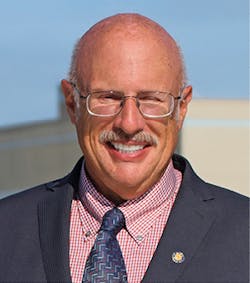As Columbus, OH’s water division administrator, Richard Westerfield has his work cut out for him. The division provides about 140 million gallons per day of drinking water to 1.1 million people, including those in 22 suburbs. The city’s three water treatment plants are rated at 125 million gallons per day (MGD); one is being upgraded to 90 MGD, and one is 50 MGD.
Columbus—the nation’s 15th largest city—is a thriving, vibrant, and growing community, notes Westerfield. That has led to more than $1 billion in capital improvement programs since he came on board 11 years ago. Water supply and treatment capabilities continue to be upgraded to meet growth. Westerfield keeps his finger on the pulse of challenges such as a recent nitrate event following fertilizer applications from farmers and other sources in the watershed. That’s being addressed through a $35 million ion exchange process at Columbus’ second-largest plant. Its largest plant is downstream of a large water supply reservoir where algae problems resulted in taste and odor issues. Ozone and biological filters added to that plant are expected to address that.
The two largest water plants are surface-water plants subject to water quality variations, such as a large rainfall that may increase the raw water source turbidity, or salt runoff from roads in the winter. Columbus has a major leak detection program to identify and repair leaks. Ten years ago, the city began a major water line rehabilitation program costing $30 million annually. Three years ago, the water division completed a comprehensive master plan for water line rehabilitation and replacement for the next 30–50 years using the triple bottom line concept, encompassing financial, environmental, and social issues.
What He Does Day to Day
Westerfield spends most of his time in meetings and providing direction and leadership to the water division’s 535 employees. He directs various projects under design, oversees operation and maintenance programs, and helps ensure optimal customer services.
What Led Him to This Line of Work
As a child, Westerfield examined water samples collected from a nearby pond under a microscope. “I always had a love for biology and chemistry,” he says. His father was a civil engineer, serving as Dayton, OH’s chief engineer for more than 30 years.
Westerfield earned a B.S. in civil engineering and an M.S. in civil and environmental engineering from the University of Cincinnati and a Ph.D. in public administration from Kennedy Western University. He then worked as a design engineer in environmental engineering with Woolpert in Dayton, a wastewater treatment engineer for the city of Dayton, and a deputy director of sanitary engineering for Ohio’s Montgomery County before becoming Columbus’ water administrator.
What He Likes Most About His Work
“The fact that we’re providing drinking water—truly the lifeblood of this community, economically and otherwise—and maintaining public health throughout the provision to more than a million people is what excites me,” says Westerfield. He’s proud of the value the division places on environmental stewardship, sustainability, and asset management.
In 2014, the department achieved ISO 14001 certification. The city also has received a Platinum Award for Utility Excellence from the Association of Metropolitan Water Agencies for its environmental and asset management programs. Westerfield credits the staff in the water division and citywide staff for being “very enjoyable, competent, knowledgeable, caring people to work with.”
His Biggest Challenge
Staying ahead of environmental regulations to ensure what the public may not even realize it needs in terms of water quality, while doing so at a reasonable rate, is Westerfield’s biggest challenge. Compared to other large municipalities, Columbus is in the middle of the rate range, he says. In addition to its strategic plan, Columbus’ water division has a climate change plan. “Studies indicate this part of the country should experience greater precipitation, but it may come down faster all at once and disappear for periods of time. We need to plan for and construct water reservoirs that can take care of drought situations.”

